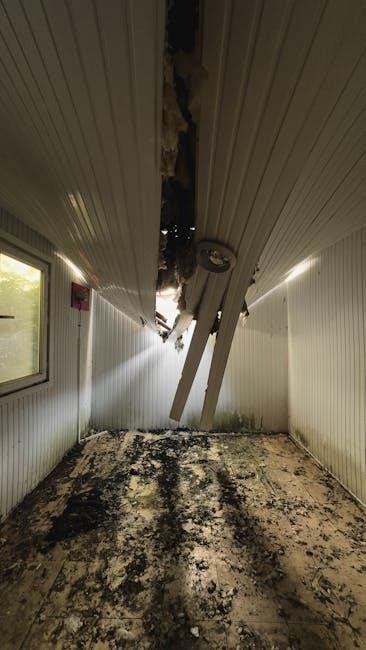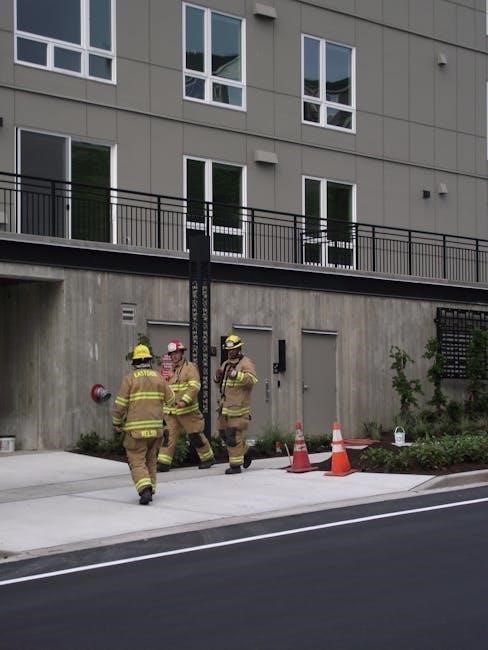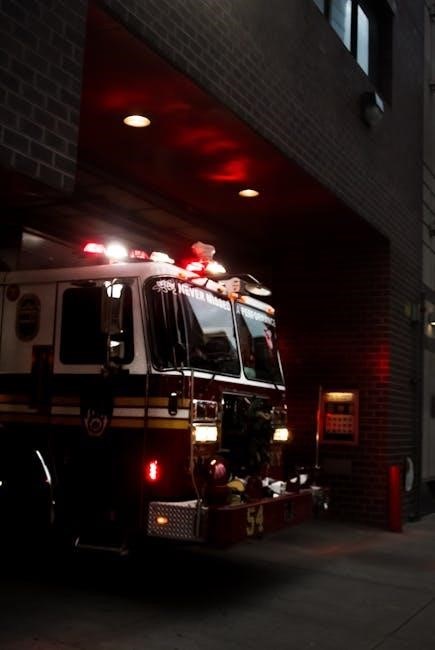Fire Alarm Categories and Grades: An Overview
BS 5839 classifies fire alarm systems based on categories and grades․ Categories define the system’s purpose‚ either manual‚ life protection‚ or property protection․ Grades‚ ranging from A to F‚ signify system quality and reliability‚ influencing component selection and power source․
British Standard BS 5839 is a comprehensive code of practice governing fire alarm system installation in the UK․ It outlines critical guidelines for ensuring fire detection and alarm systems effectively protect life and property in various buildings․ BS 5839 is divided into sections addressing different types of premises‚ including commercial‚ industrial‚ and domestic․ It classifies fire alarm systems into categories (M‚ L‚ and P) based on their purpose‚ whether manual activation‚ life safety‚ or property protection․
Furthermore‚ BS 5839 specifies grades (A to F) which define the system’s quality‚ reliability‚ and components․ Understanding these categories and grades is vital for choosing the appropriate fire alarm system that meets specific needs and legal requirements․ Recent updates to BS 5839-6:2019A1:2020 have introduced revised grading systems‚ such as D1‚ D2‚ F1‚ and F2‚ reflecting advancements and enhancing safety standards․ These revisions highlight the importance of staying informed about the latest regulations for fire alarm systems․

Fire Alarm Categories (BS 5839)
BS 5839 defines fire alarm categories based on system purpose․ These categories include manual systems (M)‚ life protection systems (L1-L5)‚ and property protection systems (P1-P2)․ Each category dictates the level and type of fire detection required․
Manual Fire Alarm Systems (Category M)
Category M‚ as defined by BS 5839‚ refers to manual fire alarm systems․ These systems rely entirely on human intervention for fire detection and alarm activation․ Unlike automatic systems‚ Category M installations do not incorporate automatic fire detectors such as smoke or heat detectors․
The primary component of a Category M system is the manual call point‚ also known as a break glass unit․ These call points are strategically located throughout a building‚ providing easily accessible points for individuals to raise the alarm upon discovering a fire․
When a fire is observed‚ a person breaks the glass or presses the button on the call point‚ which then activates the fire alarm system․ This action triggers an audible alarm‚ alerting occupants to the potential danger and initiating evacuation procedures․
Category M systems are typically used in situations where a high level of occupancy and vigilant personnel are present‚ ensuring prompt fire detection․ However‚ their effectiveness relies heavily on human awareness and responsiveness․
While simple in design and relatively inexpensive to install‚ Category M systems may not be suitable for all environments‚ particularly those with limited occupancy or where rapid fire development is a concern․ Their suitability should be carefully assessed based on a comprehensive fire risk assessment․
Life Protection Categories (L1‚ L2‚ L3‚ L4‚ L5)
BS 5839 outlines several life protection categories for fire alarm systems‚ denoted as L1‚ L2‚ L3‚ L4‚ and L5․ These categories prioritize the early detection of fire to ensure the safe evacuation of occupants․ Each level offers a different degree of protection‚ tailored to the specific risks and characteristics of the building․
Category L1 provides the highest level of life protection․ It mandates automatic fire detection in all areas of the building‚ including rooms and concealed spaces․ This comprehensive coverage ensures the earliest possible warning of a fire‚ maximizing evacuation time․
Category L2 offers a similar level of protection to L1‚ but focuses on areas with a higher risk‚ such as escape routes and high-hazard zones․ Automatic detectors are installed in these critical areas to facilitate safe egress․
Category L3 extends detection to escape routes and rooms adjoining them‚ providing a balance between cost and life safety․ This category is suitable for buildings where rapid fire spread is a concern․
Category L4 focuses solely on escape routes‚ providing a basic level of protection for occupants evacuating the building․ Detectors are placed along corridors and stairwells to alert individuals to a fire․
Finally‚ Category L5 represents a specific risk solution‚ addressing unique fire hazards identified in a risk assessment․ This category allows for tailored detection strategies to mitigate specific dangers․
Property Protection Categories (P1‚ P2)
BS 5839 also defines property protection categories‚ specifically P1 and P2‚ which prioritize minimizing damage to the building and its contents․ These categories are selected when the primary concern is to safeguard assets and ensure business continuity‚ rather than solely focusing on life safety‚ though the two are often intertwined․ Unlike life protection categories‚ property protection emphasizes early fire detection to enable swift intervention and prevent extensive damage․
Category P1 offers the highest level of property protection‚ requiring automatic fire detection throughout the entire building․ This comprehensive coverage aims to detect fires in their earliest stages‚ allowing for immediate suppression and minimizing structural damage and loss of valuable assets․ P1 systems are typically implemented in buildings housing critical infrastructure‚ irreplaceable items‚ or businesses where downtime is unacceptable․
Category P2 provides a more targeted approach to property protection‚ focusing on areas with a higher risk of fire or containing valuable assets․ This may include storage rooms‚ server rooms‚ or areas with flammable materials․ Automatic fire detection is installed in these specific zones to provide early warning and enable localized suppression efforts‚ striking a balance between cost-effectiveness and risk mitigation․

Fire Alarm Grades (BS 5839-6)
BS 5839-6 outlines fire alarm grades‚ from A to F‚ defining the system’s quality‚ components‚ power supply‚ and backup․ Higher grades offer greater reliability and are suitable for properties with increased risk or vulnerable occupants‚ ensuring optimal protection․
Grade A Fire Alarm Systems
Grade A fire alarm systems‚ according to BS 5839-6‚ represent the highest level of protection and sophistication․ These systems are typically found in commercial and industrial buildings‚ sheltered housing‚ and other complex properties where a comprehensive and highly reliable fire detection and alarm system is crucial․ A Grade A system incorporates a control and indicating equipment (CIE) panel that complies with BS EN 54-2 and power supply equipment conforming to BS EN 54-4․
These systems are designed with meticulous attention to detail‚ utilizing separate detectors‚ sounders‚ and manual call points strategically positioned throughout the building to provide early and accurate fire detection․ The system’s components are interconnected using wired connections‚ ensuring robust and dependable communication between devices․ Furthermore‚ Grade A systems often incorporate sophisticated features such as addressable devices‚ enabling precise pinpointing of the fire’s location․
The system is powered by the mains supply with a backup battery․ Grade A fire alarm systems are installed and maintained by qualified professionals‚ guaranteeing optimal performance and compliance with relevant standards․ This ensures the highest level of fire safety for occupants and property․
Grade B and C Fire Alarm Systems
Grade B and C fire alarm systems offer a step-down from the comprehensive protection of Grade A‚ providing a balance between reliability and cost-effectiveness․ These systems are typically employed in smaller commercial properties‚ offices‚ and some residential buildings where a less complex‚ yet dependable fire detection solution is required․ While sharing similarities‚ distinctions exist between Grade B and C systems․
Grade B systems usually incorporate a CIE panel adhering to BS EN 54-2 and power supply equipment compliant with BS EN 54-4‚ similar to Grade A․ However‚ the system design may be less intricate‚ potentially utilizing fewer detectors and sounders․ Grade C systems‚ on the other hand‚ are often simplified‚ potentially employing interconnected mains-powered smoke alarms rather than a dedicated CIE panel․
Both Grade B and C systems benefit from mains power with battery backup‚ ensuring continued operation during power outages․ The key difference lies in the complexity and sophistication of the control equipment and the overall system design‚ making them suitable for environments with varying fire safety needs and budget constraints․ Despite being less complex than Grade A‚ they still provide a significant level of fire protection․
Grade D Fire Alarm Systems (D1 and D2)
Grade D fire alarm systems are commonly found in domestic properties‚ offering a basic level of fire detection․ The 2019 update to BS 5839-6 refined this grade into two distinct categories: D1 and D2‚ enhancing clarity and providing more tailored solutions for homeowners․ Both D1 and D2 systems rely on mains-powered detectors with a battery backup‚ ensuring functionality even during power failures․
A Grade D1 system utilizes detectors that incorporate tamper-proof‚ long-life batteries‚ typically lasting for the lifespan of the detector․ This reduces the need for frequent battery replacements‚ offering convenience and minimizing maintenance․ Grade D2 systems‚ conversely‚ employ user-replaceable batteries‚ requiring regular checks and replacements to ensure continuous operation․ While potentially requiring more maintenance‚ D2 systems offer a lower initial cost due to the less expensive battery technology․
The choice between D1 and D2 depends on homeowner preferences and the desired level of maintenance․ D1 provides a hassle-free‚ long-term solution‚ while D2 offers a more budget-friendly option with periodic battery replacements․ Both grades provide essential fire detection capabilities for residential dwellings‚ contributing significantly to occupant safety․
Grade E Fire Alarm Systems
Grade E fire alarm systems represent a basic level of fire detection‚ primarily intended for domestic properties where a hard-wired system is desired without necessarily conforming to the more stringent requirements of Grade D․ These systems consist of interconnected‚ mains-powered smoke alarms‚ offering a network of detection throughout the dwelling․ However‚ unlike Grade D systems‚ Grade E systems do not incorporate a battery backup․
The absence of a battery backup is a key distinction‚ meaning that Grade E systems will be non-operational during a power outage․ This limitation makes them less reliable than Grade D systems‚ as fires can occur at any time‚ including during power failures․ While Grade E systems offer a cost-effective solution for interconnected fire detection‚ their dependence on mains power makes them a less robust choice for life safety․
Due to the lack of battery backup‚ Grade E systems are typically recommended only in situations where power outages are infrequent and the risk of fire during such outages is deemed low․ Homeowners should carefully consider the potential risks before opting for a Grade E system‚ weighing the cost savings against the reduced level of protection compared to systems with battery backup capabilities․
Grade F Fire Alarm Systems (F1 and F2)
Grade F fire alarm systems represent the most basic level of fire detection‚ primarily intended for existing domestic properties where hard-wiring is impractical or cost-prohibitive․ These systems rely on battery-powered smoke alarms and are further subdivided into F1 and F2 categories‚ each with distinct characteristics;
Grade F1 systems consist of one or more battery-powered smoke alarms utilizing tamper-proof primary batteries․ These batteries are designed to prevent easy removal‚ ensuring continuous operation for the expected lifespan of the alarm․ Grade F2 systems‚ on the other hand‚ employ one or more battery-powered smoke alarms using user-replaceable batteries․ Regular battery checks and replacements are crucial for maintaining the functionality of F2 systems․
While Grade F systems offer a simple and affordable solution for fire detection‚ their reliance on batteries necessitates regular maintenance to guarantee their effectiveness․ It is essential for homeowners to adhere to the manufacturer’s recommendations for battery testing and replacement to ensure the alarms are always operational․ Despite their simplicity‚ Grade F systems provide a valuable layer of protection in homes where more sophisticated systems are not feasible․

Updated Alarm Grades in BS 5839-6:2019A1:2020
The BS 5839-6 standard‚ which specifically addresses fire alarm systems in domestic premises‚ underwent significant revisions in the 2019 amendment A1:2020․ These updates introduced crucial changes to the grading system‚ aiming to provide clearer distinctions and enhance the effectiveness of fire detection in residential settings․ One of the key modifications was the redefinition of Grade C systems․
Furthermore‚ Grade D was replaced by two distinct categories: D1 and D2․ Similarly‚ Grade F was superseded by F1 and F2‚ offering more granular options based on the power source and battery type used in the alarm systems․ These changes reflect a move towards greater precision in specifying the appropriate fire alarm system for different types of domestic properties and occupancy risks․
The updated standard provides detailed guidance on the selection‚ installation‚ and maintenance of fire alarm systems‚ ensuring that they meet the specific needs of the occupants and the building․ Understanding these updated grades is essential for ensuring the safety and compliance of fire alarm systems in domestic environments‚ promoting timely detection and response to fire incidents․

Choosing the Right Fire Alarm System
Selecting the appropriate fire alarm system is paramount for ensuring the safety of occupants and protecting property․ The decision-making process involves careful consideration of several factors‚ including the type of building‚ its occupancy‚ potential fire hazards‚ and relevant regulatory requirements‚ particularly BS 5839 standards․ Understanding the different fire alarm categories‚ such as manual (M)‚ life protection (L)‚ and property protection (P)‚ is crucial․
Life protection systems are further divided into categories like L1‚ L2‚ L3‚ L4‚ and L5‚ each offering varying levels of coverage and detection capabilities․ Property protection systems‚ P1 and P2‚ focus on minimizing damage to the building and its contents․
Furthermore‚ selecting the correct grade‚ ranging from A to F‚ is essential․ Higher grades denote more robust and reliable systems․ Consulting with qualified fire safety professionals is highly recommended to conduct a thorough risk assessment and determine the most suitable fire alarm system for your specific needs․ They can provide expert guidance on system design‚ installation‚ and maintenance‚ ensuring optimal performance and compliance with applicable standards‚ ultimately safeguarding lives and assets․





